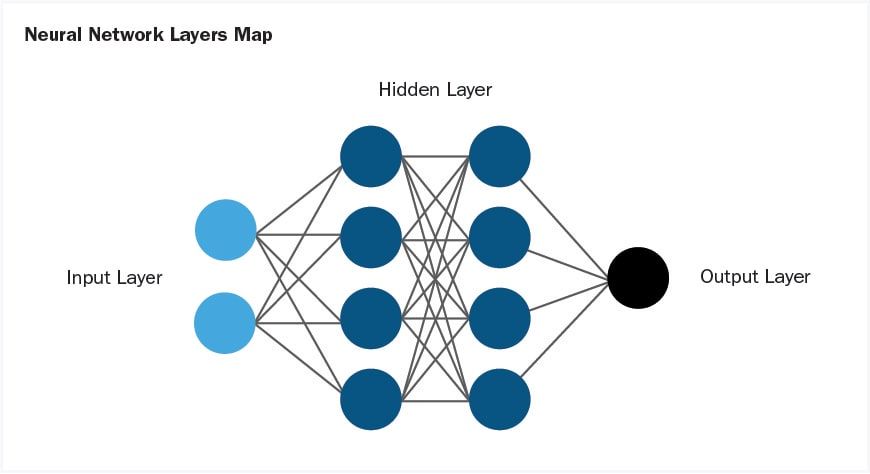In the dynamic and competitive world of B2B markets, it is crucial to leverage Artificial Intelligence (AI). AI offers significant advantages for businesses striving to stay competitive, maximize profits, and ensure business sustainability. Embracing AI empowers businesses to model market trends, improve customer experiences, and streamline operations. Thus, positioning them for long-term success.
So far, segmentation approaches have been the go-to method to set prices based on distinct customer segments. Due to recent advancements in technology, neural networks have emerged as a superior alternative for B2B price optimization despite their complexity.
Read on to learn about neural networks and their advantage over segmentation-based approaches.
Neural Networks
Neural networks are a powerful technology that mimics how the human brain processes information. Like the brain’s nerve cells, neural networks are a large web of interconnected “neurons” that work together to recognize patterns or solve business problems. Neural networks consist of multiple layers of neurons that process input data and pass information to the next layer in the network.
The input layer is where you provide all the relevant information. Like sales history data, customer and product details, market trends, and competitor pricing.
The network has one or more hidden layers, each consisting of multiple neurons that process the data through various transformations and calculations. The more hidden layers there are, the deeper and more nuanced the analysis becomes. This enables the network to model complex relationships and interactions in the data.
The output layer is like your final pricing decision. After processing all the data through various layers, this layer provides the result, such as the optimal price for a product or service.

Neural networks can help businesses decide the best prices for their products and services. But how do they compare against the traditional approach of using segmentation to make pricing decisions?
Holistic Data Integration and Processing
Neural networks have a significant advantage over segmentation-based models: their ability to use a wide variety of data for B2B price optimization.
In recent years, an increasing number of companies have been recognizing the value of data in driving strategic decisions and competitive advantage. This has led to a significant surge in data collection efforts. Businesses now gather vast amounts of information on their historical customer quotes. Companies are also collecting data from external sources – competitor prices, social media, and market trends. The rise of big data has highlighted the limitations of segmentation models. They tend to rely on a few predefined attributes, such as customer industry, geography, or company size, to categorize data into segments.
In contrast, neural networks are designed to handle diverse and complex datasets. They can deal with numerical attributes like competitor prices without needing to bucket them. Additionally, they can work with a variety of data types:
- Structured data: such as transaction records
- Unstructured data: customer feedback and social media trends
This allows neural networks to capture intricate patterns in the data, leading to more accurate and dynamic pricing decisions. By integrating and learning from a variety of data, neural networks provide a holistic view of market conditions and purchasing patterns. Thus, enabling more effective price optimization strategies that traditional segmentation methods cannot achieve.
Data Sparsity Handling
Neural networks excel in handling sparse datasets for B2B price optimization due to their ability to learn from and generalize across limited data points. Unlike traditional segmentation approaches, which often struggle with sparse data. Segmentation relies on predefined segments and requires enough data within each segment to make reliable pricing decisions. When the data is sparse, the segmentation-based methods usually use a handful of attributes to make pricing decisions, making them less effective.
Neural networks leverage their deep learning capabilities to capture complex patterns and relationships even in sparse datasets. They can integrate various data inputs, identify subtle correlations, and extrapolate meaningful insights. Thus, providing robust pricing strategies even when individual data segments lack enough volume.
It is important to note that neural networks can be prone to overfitting. Overfitting is when the model not only learns the patterns in the data but also the noise. That leads to the model performing really well on training data but poorly on unseen data. To combat this, neural networks can use regularization techniques like dropout to help the model generalize to new, unseen data, ensuring businesses can derive actionable insights from limited information.
Handling Complexity
Neural networks have advanced pattern recognition, offering a significant advantage over traditional segmentation approaches in B2B price optimization.
Segmentation methods simplify the data into a few segments. This could lead to it missing subtle and complex patterns within the data. It may struggle with multidimensional data, where multiple attributes interact in complex ways to influence pricing.
Neural networks, however, are designed to identify complex, non-linear relationships across various attributes. They analyze many attributes at the same time to uncover insights that segmentation might overlook. This advanced pattern recognition enables neural networks to provide very accurate and nuanced pricing recommendations tailored to account-specific needs and market conditions.
Neural networks continuously learn from new data, improving their accuracy and performance over time without human intervention. This leads to pricing strategies that are more effective and adaptable to market trends.
In contrast, segmentation’s more static and simplistic analysis can result in less precise and adaptable pricing solutions. Thus, limiting its ability to respond to the complexities of modern B2B pricing.
Scalability and Flexibility
Neural networks are highly flexible and scalable compared to segmentation for B2B price optimization.
Segmentation relies on static segments to group customers/transactions that can become obsolete as the data changes over time. Adding more attributes or segments or adjusting existing ones requires significant manual effort.
Neural networks dynamically adapt to changes in data and market conditions. This flexibility allows them to refine their analysis regularly. Thus, providing more precise and market-driven pricing recommendations. Additionally, neural networks can scale to handle increasing volumes of data without losing performance. This scalability ensures that as more data becomes available, they can process and learn from it. This leads to continuously improving and more accurate pricing recommendations.

Dynamic Pricing
Various external factors, such as market trends, competitor pricing, and changes in production costs, often impact B2B pricing.
Segmentation-based methods typically rely on business rules to adjust pricing recommendations and account for shifts in these market conditions.
In contrast, neural networks excel in managing these numerical variables within the model to enable dynamic pricing. Based on current market conditions, these models adjust prices in real-time, ensuring businesses can respond swiftly to changes. For instance, if a competitor lowers prices, the model can automatically adjust prices to maintain competitiveness. This dynamic response helps protect profit margins while maintaining market share in a volatile environment.
Model Interpretability
In B2B pricing, users need to be able to interpret and understand the recommendations generated by the models.
Segmentation approaches rely on clear, predefined segments. That makes it easy to understand how pricing decisions are derived.
Neural networks are often seen as “black boxes” as it can be challenging to understand them due to their complex layers and extensive computations. Therefore, interpretability models play a crucial role in leveraging neural networks for B2B price optimization by providing transparency and understanding of how these complex systems make pricing decisions.
Interpretability models such as SHAP (SHapley Additive exPlanations) and LIME (Local Interpretable Model-agnostic Explanations) enable businesses to decipher the factors influencing pricing recommendations. By identifying and explaining the contribution of various attributes, these models ensure that users can trust and validate the outputs of neural networks. This transparency facilitates more informed decision-making and increases the adoption and effectiveness of AI-driven price optimization solutions.
Competitive Advantage
In today’s competitive business environment, having an edge over competitors is crucial. Price optimization powered by neural networks provides that competitive advantage. Neural networks allow businesses to stay ahead of market trends, react quickly to changes, and offer optimized pricing to meet customer needs. Companies that leverage neural networks for price optimization are better equipped to navigate the complexities of the modern dynamic marketplace and achieve sustainable growth.
Are You Ready for Price Optimization with Neural Networks?
Simply put, neural networks provide more precise and dynamic pricing tailored to account-specific behaviors and market conditions. Neural networks continuously learn and adapt to new data, ensuring pricing remains relevant and competitive. This adaptability reduces the risk of underpricing or overpricing. Thus, leading to user adoption, customer satisfaction, and increased sales. Consequently, the enhanced accuracy and responsiveness of neural networks translate into a higher ROI than traditional segmentation’s static and less flexible approach. The important follow-up question is: Is your business ready to harness the power of neural networks for price optimization?
Incorporating artificial intelligence into B2B price optimization is essential for businesses looking to succeed in a competitive market.
By leveraging AI’s capabilities, companies can:
- make more informed, data-driven pricing decisions
- improve customer satisfaction through market-driven pricing
- maximize profits
However, before diving into AI for price optimization, businesses must establish a solid foundation in price management. This involves understanding your market, setting clear pricing objectives, and implementing basic pricing strategies that reflect your business goals and customer needs. This foundational work ensures that your data is clean, your processes are efficient, and your team is ready to leverage AI for more sophisticated, dynamic, and accurate pricing decisions.
After establishing a solid foundation in price management, companies can transition to using neural networks for price optimization. Starting directly with neural networks might seem daunting, but it can provide faster and more accurate pricing decisions.
While segmentation approaches have been valuable in B2B price optimization, the complexities of modern markets demand more sophisticated solutions. With rigid segments and manual adjustments, segmentation can be an unnecessary intermediary step that can delay the benefits of more advanced and efficient technologies.
Neural networks can handle diverse and complex datasets and learn and adapt to market changes and purchasing patterns. By skipping segmentation, companies can avoid the potential pitfalls of oversimplified analyses and instead leverage the full power of neural networks to achieve more precise, dynamic, and scalable pricing solutions from the outset. Despite their complexity, the benefits of neural networks in terms of accuracy, scalability, and dynamic responsiveness far outweigh the challenges. The recent advancements in the model interpretability field make neural networks an obvious choice. Embracing neural networks for price optimization today means positioning your business for a more profitable and competitive future.
Read More
- Ensuring Transparency in Price Optimization: Unveiling the Strengths of AI-powered Pricing Strategies
- How AI-Powered Pricing Transforms Data into Dollars
Frequently Asked Questions
Neural networks mimic the human brain by using interconnected “neurons” to process data. They analyze input data, such as sales history and market trends, through multiple layers to provide optimized pricing recommendations.
Unlike segmentation, which relies on predefined attributes, neural networks handle diverse and complex datasets, identify intricate patterns, and adapt dynamically to market changes, offering more accurate pricing.
Neural networks excel in sparse datasets by leveraging deep learning to generalize across limited data points, identifying subtle correlations and providing robust pricing strategies.
Neural networks enable real-time price adjustments based on market trends, competitor pricing, and aggregate customer behavior insights, ensuring businesses remain competitive and responsive.
Yes, neural networks are highly scalable, processing increasing volumes of data while continuously improving pricing accuracy and adapting to evolving business needs.
Interpretability models like SHAP and LIME help businesses understand how neural networks derive pricing recommendations, ensuring trust and informed decision-making.
Neural networks provide precise, dynamic, and market-driven pricing strategies, helping businesses stay ahead of trends, improve profits, and enhance customer satisfaction.

